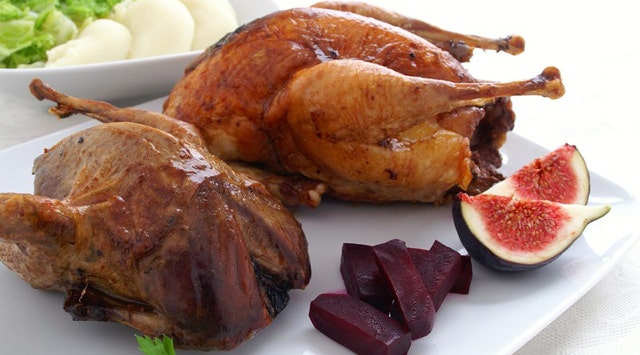It was only a few miles away from the site of that feat, but quite a few years later, that I faced my own Highland challenge. Whilst taking part in the BBC’s MasterChef competition I was given many extraordinary trials and opportunities but the most remarkable and easily my favourite was when we were taken to Scotland and asked to cook lunch for the competitors in the Highland Games near Dornoch.
The ten of us who were left at that stage of the contest were divided into two teams, each of which was allocated a collection of glorious local Scottish ingredients from which we were tasked with cooking two main course dishes and a pudding. My team were given a rather eerily creaking pile of live langoustine and were slightly envious of the other team’s whole salmon which, as our langoustine kept trying to creep off and evade the pot, felt like a much more straightforward ingredient to deal with. Similarly, we were slightly miffed that whilst our fillets of beef were of utterly beautiful quality and a joy to cook with, we might have been even more excited by the wonderful venison fillets being prepared in our opponents’ tent.
However, despite feeling that we had lost out a little to the other team in the allocation of ingredients my team won the day. As a prize we were given the thrilling opportunity to cook for a private dinner being hosted that evening by the Chairman of the Carnegie Club at Skibo Castle. Even more exciting for us was that we were cooking a menu devised by the extraordinary Scottish chef, Tom Kitchin, and that Tom would be there in the kitchen supervising us all evening. The icing on the cake for me was that I was to be jointly in charge of the main course for dinner; a classic Roast Grouse with game chips and bread sauce.
With such a distinct and dominant flavour, simplicity is undeniably the best approach and it would be hard to find a better way to celebrate the flavour depths of grouse than the classic roast. Its accompaniments need do nothing more than provide a harmonious background and allow the bird to shine but even so it is important to get every element right.
 A roast grouse is a marvellous thing and my experience on MasterChef was amazing - but there are other ways to enjoy grouse this summer.
A roast grouse is a marvellous thing and my experience on MasterChef was amazing - but there are other ways to enjoy grouse this summer.Having had a masterclass from such a revered Scottish chef I could never deviate from Tom Kitchin’s method which produced beautifully tender meat complemented impeccably by its trimmings. Having plucked and drawn the grouse outside one of the back doors of the castle, Tom showed me how to prepare the birds for roasting by trussing them along with a strip of pancetta over the breasts. They were browned in oil in a pan with butter and thyme and basted frequently until the breasts were golden all over when they were roasted in the oven at 200°C for 3 minutes on each breast and another 5 minutes on their backs. Finally they were rested in a warm place for 10 minutes, breast side down.
For the bread sauce, I brought 250ml whole milk just to the boil with a large onion studded with 2 cloves. Having simmered the milk for 10 minutes I strained it into a clean pan, added 1 tbsp butter and then (off the heat) whisked in 110g cubed, crustless white bread. This was all stirred together until it thickened and was then seasoned with salt, white pepper and some freshly grated nutmeg. I finished it all off with another tablespoon of butter (this was my suggestion, rather nervously raised but immediately endorsed by Tom, never have I been more proud). The sauce can be prepared well in advance (and freezes beautifully) and simply needs re heating with that final tablespoon of butter when you’re ready to serve.
The roasted birds were served on a fricasee of wild mushrooms with game chips on the side. The mushrooms, having been cleaned and trimmed were simply fried in butter with thyme until cooked through and tender, and the potatoes were finely cut into a lattice pattern on a specialist mandolin before being deep fried. If the latter sounds like a step too far I can highly recommend substituting them with a generous bag of the root vegetable crisps that are so widely available these days.
This is the perfect way to treat the early birds of the season; classic simplicity at its best, but as the weeks pass and the freezer fills it’s not surprising that we start to crave a bit of variety and cast around for some less orthodox treatments. As a development of the classic roast and a good way to treat slightly older birds, I like to take the legs off and roast the crown alone. This can either be served whole or with the breasts carved off which does make them so much easier for the diner to tackle. As the autumnal months bring cooler weather a creamy celeriac puree and some braised savoy cabbage with chestnuts and pancetta stirred through are a perfect seasonal adjunct; the very slight acidity and distinctive flavour of celeriac complements the rich gaminess of grouse beautifully.
Let’s be honest; being so much harder working the legs of game birds are not always their finest feature particularly in older specimens. Compared to the tender, meaty breasts, temptingly pink and melting in the mouth, it is easy to allow the accompanying limbs to end up rather dry and tough, hardly worth the fight it can require to persuade the meat off the bone. Not wanting to waste any part of our birds, however, they just need a little sympathetic treatment after which they can match any breast in terms of flavour and succulence. The best way to achieve this is to braise the legs separately, either in some chicken stock or in duck fat. In both cases I would add a bay leaf, clove of garlic, sprig of thyme and some whole pepper corns or juniper berries to the pot and leave them simmering oh so gently for at least an hour, ideally 2, until the meat is wonderfully tender. The braised legs can be browned in the oven and served whole alongside the crown or breasts. Alternatively you can strip the meat, chop it finely and shape it into small, elegant ballotines.
For a real change though, and given that grouse comes into season now while we are still (hopefully) basking in the warmth of summer, I think it’s useful to have a less autumnal recipe to enjoy.
Grouse and salad are not necessarily the most obvious bedfellows but the flavours in this work remarkably well. Pomegranate is one of my favourite ingredients and I use the seeds and the molasses (available in most supermarkets) in many sweet and savoury recipes. Its intensely sharp sweetness cuts perfectly through the richness of grouse, taming it for this lighter, summery treatment. Finely shaved raw fennel adds texture and a hint of spice with its mild, anise-like flavour and peppery watercress brings it all together. This recipe may appear to be a curious combination of ingredients but they intermingle to offer a light, unusual and utterly delicious way to enjoy grouse while the summer sun is still shining.
Grouse salad with fennel, watercress and pomegranate Serves 4
For the grouse 2 grouse crowns 1 tbsp sunflower or rapeseed oil Knob butter
For the salad 2 tbsp Pomegranate molasses 2 tbsp sunflower or rapeseed oil plus a little extra 1 tsp Dijon mustard 2 tbsp lemon juice, plus a bit extra 1 large bulb fennel 100g watercress, larger stalks removed Seeds from 1 pomegranate Salt and pepper
- Pre heat the oven to 200°C. Heat a pan on the hob and when up to temperature add the oil. Season the grouse crowns and brown on all sides in the pan; start it on one breast then turn it onto another and when you put it on its back add the knob of butter and baste the breasts liberally. Transfer the pan to the oven and roast the crowns for 8 minutes. Rest, breast side down, and allow to cool.
- Put the pomegranate molasses, oil, Dijon mustard and lemon juice into a jar, add a pinch of salt and shake well to mix and emulsify. Keep in the fridge until you need the dressing.
- Cut the fronds off the fennel and remove the harder outside leaves. With a mandolin or sharp knife cut the rest into very thin slices and toss in the extra oil and lemon juice to stop it discolouring.
- Remove the grouse breasts from the crowns and carve them lengthways.
- Toss the fennel and watercress together and arrange the mixture prettily in the middle of your plates. Sit the slices of grouse on top and drizzle the dressing over and around it before sprinkling with pomegranate seeds.
- Finally garnish with a twist of black pepper and some fennel fronds.
2015-08-11 07:59:53
27 view(s) 


